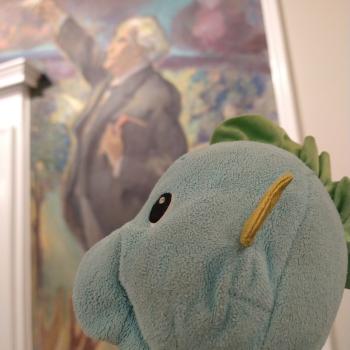Read more about the conference here:
I’m almost at the end of my time with the roomful of medical professionals at Grace Prescriptions, and I have a lot to chew on (and I don’t just mean the chocolate: we’ve all been fed within an inch of our lives!)
Last night focused on making the theological, Biblical, and scientific cases for the intersection of faith and medicine. Today was much more practical, talking to the doctors present about how they could use “faith flags” (subtle comments about the role of faith in their own lives), “faith stories” (telling brief stories about their own religious experiences) and “faith prescriptions” (encouraging prayer, Scripture reading, or other spiritual practices, especially to patients who are already Christian believers). Serious attention was also given to the role of prayer in medical practice; praying for patients and (with permission) praying with patients, especially at serious moments in their medical lives (serious illness, birth of a child, and the like.)
I actually found these approaches helpful as a religious professional too. People in my line of work, whether that’s my line of work as a journalist or as a pastor, are good at talking to people. We’re not always so good at listening. (At least I’m not.) It is good and wise to remember that God is working in people’s lives before we meet them and after we pass by, and that the most powerful witness we can make to God’s power to change lives is not preaching a sermon, but actually living a changed life and a joyful life in front of them.
For someone who is (as I said in my last post) a good mainliner, and a good Wesleyan-Arminian to boot, I felt there was more attention paid to the process of leading people to Christ–although that attention was given with clear nuance and attention to the way evangelism is a process and not simply a transaction–than attention paid to how medical professionals should interact with patients who are already Christians but who need help integrating that faith with the confusing maze of modern medicine.
The cycle of evangelism presented to help medical professionals consider whether they were planting, cultivating, harvesting, or multiplying the seed of the gospel did give a place to the act of multiplying and making disciples, but the bulk of the attention today seemed to be focused on leading patients to Christ. There’s a whole other conference to be had–or at least a whole other slant on this material–on how healthcare professionals can walk alongside those of us who have already been walking with Christ. On the whole, I did feel the presence of the Reformed presuppositions that run through much of the faith and work movement–the strong cleavage between unbelievers and believers, between what has been redeemed and what has not been, that seems to be assumed, even as it is acknowledged that common grace works among unbelievers and that we ought not to make distinctions between sacred and secular. (My response the first time I heard that last point argued: “Duh, prevenient grace!”)
Be that as it may, I was still encouraged by the experience–and especially by the constant calls to prayer, sensitivity, and attentiveness to the role of the Holy Spirit. Knowing that the 12 health professionals I met with are going out into the world with a renewed desire to pray for healing and peace in troubled times, and with troubled people, strikes me as a very good thing. I’m hoping to follow up with a few of them over the next weeks and months. Stay tuned!














